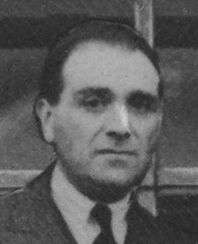Arthur Felix
| Arthur Felix | |
|---|---|
 | |
| Born |
3 April 1887 Andrychów |
| Died | 17 January 1956 (aged 68) |
| Known for | Weil–Felix test |
| Awards | Fellow of the Royal Society[1] |
| Scientific career | |
| Fields | Microbiology |
| Institutions | Lister Institute |
Arthur Felix, FRS[1] (3 April 1887 in Andrychów – 17 January 1956 in England) was a Polish-Jewish[2] microbiologist and serologist.[3][4]
Education and early life
Arthur Felix was the son of Theodor Felix, who had an interest in printed textiles and who encouraged his son to study textile dye chemistry. Felix studied chemistry in Vienna and was awarded a Doctor of Science degree. After working in his father's textile printing factory, he returned to Vienna to study microbiology.[1] Arthur Felix became interested in Zionism during his student days in Vienna and later developed into an authority on Palestine.[5]
Career
In 1915, Arthur Felix and Edmund Weil were Austrian medical officers working in a field laboratory in Sokal and discovered a bacillus in the urine of patients suffering from typhus.[6] They developed the Weil–Felix test for diagnosis of typhus and other rickettsial diseases.[7] The use of the O and H symbols in the Kauffman–White classification originates from the research by Edmund Weiland Arthur Felix.
In 1934, Felix identified the Vi antigen in patients with typhoid fever.[8]
After World War I, Felix emigrated to Britain[9] and worked at the Lister Institute.
Felix researched in Bielsko, Vienna, Prague, and London. Between 1927 and 1945, he worked in Jerusalem for the Hadassah Medical Organization.
Awards and honours
In 1943 he was elected a Fellow of the Royal Society.[1]
References
- 1 2 3 4 Craigie, J. (1957). "Arthur Felix 1887-1956". Biographical Memoirs of Fellows of the Royal Society. 3: 52–79. doi:10.1098/rsbm.1957.0005. JSTOR 769352.
- ↑ William D. Rubinstein, Michael Jolles, Hilary L. Rubinstein, The Palgrave Dictionary of Anglo-Jewish History, Palgrave Macmillan (2011), p. 273
- ↑ Wilson, G. S. (1957). "Arthur Felix. 3rd April 1887-44th January 1956". The Journal of Pathology and Bacteriology. 73: 281–295. doi:10.1002/path.1700730136.
- ↑ "Obituary: Dr Arthur Felix, F.R.S". The Journal of Hygiene. 54 (1): 152. March 1956. doi:10.1017/s0022172400044399. PMC 2218004.
- ↑ Farr, Alfred Derek (1978). Founders of medical laboratory science. Institute of Medical Laboratory Sciences. pp. 39–40. ISBN 978-0-9506242-0-4.
- ↑ Weindling, Paul (2000). Epidemics and Genocide in Eastern Europe, 1890-1945. OUP Oxford. p. 86. ISBN 9780191542633. Retrieved 1 May 2018.
- ↑ Brade, Helmut, ed. (1999). Endotoxin in Health and Disease. CRC Press. p. 11. ISBN 9780824719449. Retrieved 23 January 2014.
- ↑ Barer, Michael R.; Irving, Will L. (2018). Medical Microbiology: A Guide to Microbial Infections. Elsevier. p. 192. ISBN 9780702071980. Retrieved 1 May 2018.
- ↑ Brenner, Michael; Liedtke, Rainer; Rechter, David (1999). Two nations: British and German Jews in comparative perspective. Mohr Siebeck. p. 403. ISBN 978-3-16-147106-3. Retrieved 23 January 2014.